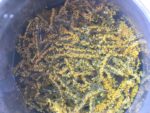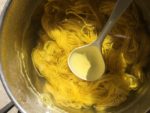
Goldenrod is a fantastic source of saturated, yellow dye, and one of the plants that I recommend starting with if you are new to natural dyeing.
Step 1: Prepare the yarn.
Mordant the wool with alum. I use a 10% by weight-of-goods proportion of alum to wool. Botanical Colors has a great tutorial on mordanting with alum.
Step 2: Prepare the goldenrod.
Here in Vermont, goldenrod matures and blooms in July or August. I use big pruning shears or kitchen scissors to carefully harvest the flower fronds, trying not to pick too many leaves or stems in the process. Gather enough to fill your dye pot 3/4 full.
Step 3: Extract the dye and wet the yarn.
Place the pot on your heat source and top up with warm water, then add heat and bring to a gentle simmer (180 – 190 F). Stir occasionally and cook for about 20 – 30 minutes.
While the color is extracting, wet your yarn out in hot water in a covered container (like a bucket or extra pot with a lid) to retain the heat.
When the color of the dye is looking saturated, strain off the liquid into another pot or bucket. I use a mesh paint strainer for this purpose to catch all the fine plant material.
Step 4: Dye the fiber.
Pour the dye liquid into your dye kettle and place back on the heat source.
Gently lift your yarn or fiber out of the soaking container and place into the dye kettle. Give it a gentle stir and poke to submerge.
Simmer the yarn in the dye bath for at least an hour, giving it a gentle swish every once in a while (too much agitation can felt the yarn so stirring should be infrequent).
After about an hour, turn off the heat and cover the pot. I like to leave my dye kettles overnight to cool slowly.
Step 5: Rinse and dry.
Gently lift the fiber out of the dye kettle and allow the excess dye liquor to drain back into the pot. Then transfer to a bucket of clean water and let soak for a couple of minutes. If necessary, lift the fiber out of the rinse bucket and place into a third bucket or pot of clean water, to rinse a second time. I’ve found goldenrod doesn’t need much rinsing.
In a shady spot, hang the wet yarn up to dry or drape over the back of a lawn chair and allow to dry. You might want to bring the yarn inside after it stops dripping, as humidity in the air can keep it from drying completely outside.
Have you tried dying with goldenrod? We’d love to know. Leave a comment here or on the accompanying video and let us know how it turned out.



